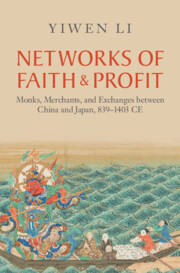Book contents
- Networks of Faith and Profit
- Asian Connections
- Networks of Faith and Profit
- Copyright page
- Dedication
- Contents
- Illustrations
- Acknowledgments
- Maps
- 1 Introduction
- 2 Replacing Tributary Relations
- 3 Not Only for the Dharma
- 4 Building a Base for Trade
- 5 Transporting Goods and Faith
- 6 Sending Ships to China to Finance Monastery Construction
- 7 Resuming Tribute Relations and the Aftermath of the Religio-commercial Network, 1368–1403
- Bibliography
- Index
- Asian Connections
6 - Sending Ships to China to Finance Monastery Construction
Trade between the Mongol Empire and the Japanese Archipelago, 1270–1368
Published online by Cambridge University Press: 25 May 2023
- Networks of Faith and Profit
- Asian Connections
- Networks of Faith and Profit
- Copyright page
- Dedication
- Contents
- Illustrations
- Acknowledgments
- Maps
- 1 Introduction
- 2 Replacing Tributary Relations
- 3 Not Only for the Dharma
- 4 Building a Base for Trade
- 5 Transporting Goods and Faith
- 6 Sending Ships to China to Finance Monastery Construction
- 7 Resuming Tribute Relations and the Aftermath of the Religio-commercial Network, 1368–1403
- Bibliography
- Index
- Asian Connections
Summary
The two failed Mongol invasions of Japan in 1274 and 1281 launched a new phase in the history of Sino-Japanese trade, during which religious institutions played an even more important role. This chapter shows that despite the occasional conflicts between Chinese officials and merchants from Japan, Sino-Japanese trade continued on a large scale with the direct participation of prominent Japanese monasteries in both Kyoto and the newly developed political and religious center of Kamakura. Monasteries directly sending trade ships to China, often in the name of financing monastery construction, constituted a further development in the integration of religious and trade networks predating the Mongol invasions. In the mid-fourteenth century, increasing piracy and the changing political environment in both China and Japan prompted monasteries to adopt precautionary procedures to secure their profit, including signing contract-like documents with the merchants they commissioned.
Keywords
- Type
- Chapter
- Information
- Networks of Faith and ProfitMonks, Merchants, and Exchanges between China and Japan, 839–1403 CE, pp. 128 - 163Publisher: Cambridge University PressPrint publication year: 2023



